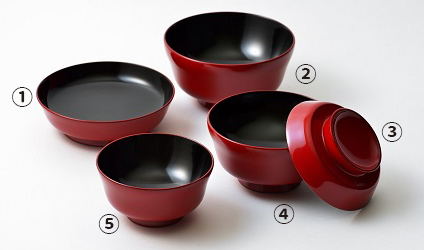
鎌倉時代にこの地方を支配していた領主の弟が、地元の山から切り出されたブナの木や漆を利用して、武具に漆を塗ることを内職として家臣に命じたのが始まりとされています。
本格的に椀作りが始まったのは江戸時代中期からで、後期には今の川連、大館、三梨の3地区を中心に発展し、一般生活用品の産地として栄えました。

The beginnings of this craft go back to the Kamakura period (1185-1333), when the younger brother of the lord of the fief who ruled this area, ordered the retainers to take up lacquering pieces of armor and weaponry as a job, using locally tapped lacquer and Japanese beech cut from the mountains in the area. The making of bowls began in earnest in the middle of the Edo period (1600-1868) and by the end of the period work was concentrated on the three districts of Kawatsura in what is now Inakawa-cho, Odate and Minashi and the making of everyday pieces of household goods flourished in what had become a production center.
The carcasses of all the pieces are made of wood on to which natural lacquer is applied. There is no one particular feature that characterizes this ware but, because emphasis is placed on the undercoating to produce a very hard finish, it is extremely robust and is also reasonably priced. A wide variety of products are produced ranging from bowls, plates, trays and stacking boxes up to items of furniture. There are 177 firms employing 620 people, among whom 38 are government recognized Master Craftsmen all dedicated to the perpetuation of this fine japanned craft.
たなごころセット
①中皿(直径14φ×4cm)
②飯椀(直径13.5φ×6.8cm)
③小皿(直径11.2φ×3.5cm)
④汁椀(直径12.1φ×6.4cm)
⑤小鉢(直径10.6φ×5.5cm)